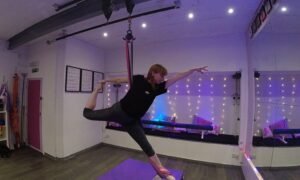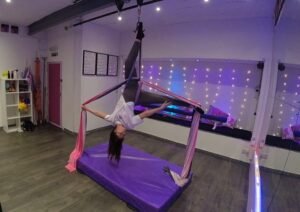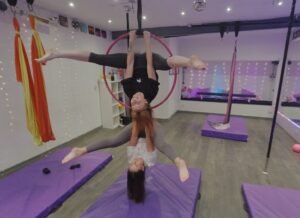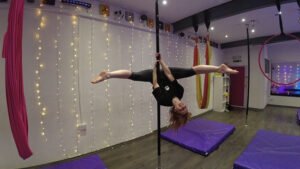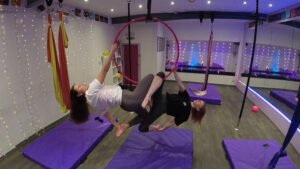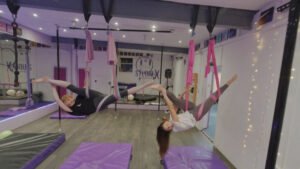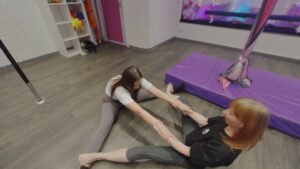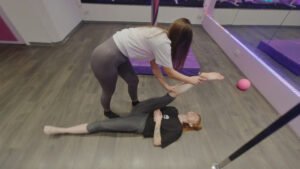Have you ever considered trying pole dance? You might be surprised to learn that it’s
not just an art form or a dance style—it’s an empowering and thrilling way to build
strength, boost your confidence, and improve your fitness in ways you’ve never
imagined.
Pole dance is often misunderstood as a performance art, but it’s also a rigorous and
dynamic workout that requires strength, flexibility, and focus. You’ll use muscles you
didn’t even know you had! With each spin, climb, and hold, you’re engaging your
core, toning your arms, and building leg strength—all while feeling the rush of
adrenaline and accomplishment.
Did you know? Pole dance was recently recognized as a competitive sport. In 2017,
the Global Association of International Sports Federations gave it “observer status”
as an official sport. This shift in perception has helped break down stereotypes and
opened the door for people of all backgrounds to participate.
Where Pole Dance Began: From Ancient Cultures to Modern Fitness
Pole dance has surprisingly deep and diverse roots. Although it’s seen as a modern
form of exercise and entertainment, elements of pole dancing can be traced back
centuries. The origins of pole dance are often linked to two ancient practices:
- Mallakhamb: This ancient Indian sport dates back over 800 years and
involves performing acrobatics and poses on a wooden pole. Mallakhamb was
originally a training practice for wrestlers to improve strength, flexibility, and
agility. Even today, Mallakhamb athletes perform feats that require immense
body control, and it is regarded as a national sport in India. - Chinese Pole: This form of acrobatics originated in China and involves
performers climbing, flipping, and balancing on poles up to 20 feet tall.
Traditional Chinese pole acts are still popular in circuses and require extreme
strength and stamina. Although it differs in style and technique, Chinese pole
shares the physical discipline and body control seen in pole dance today.
Over time, these ancient practices evolved and blended with modern dance and
fitness movements to create the pole dance we know today. What started as athletic
training and ritual performance has transformed into a global phenomenon
celebrated for both its athleticism and artistry.
Uncommon Facts About Pole Dance - Not Just for Gyms and Studios: Pole dance is growing in unexpected spaces.
It’s becoming a popular sport at fitness festivals and even being integrated into some
yoga and Pilates studios as a way to enhance core strength and flexibility. There’s
even a push for pole dance to be included in the Olympics, which would further
establish it as a respected sport worldwide.
- Benefits Beyond Muscles: Pole dance is known for its ability to tone and sculpt,
but studies suggest it also reduces stress and improves mental clarity. The
combination of movement, rhythm, and mental focus creates a meditative effect
similar to “flow” states experienced in activities like rock climbing or dance. - Famous Dancers and Celebrities Love It: Many celebrities have tried pole
dance to improve fitness and confidence, including Jennifer Lopez, Madonna, and
even Hugh Jackman, who have shared how empowering they found the experience.
Additionally, famous dancers like Evgeny Greshilov and Felix Cane have brought
worldwide recognition to the sport, demonstrating that pole dance is about strength,
artistry, and pushing limits.
Build Confidence and Self-Esteem
Pole dance isn’t just about physical power—it’s about embracing and celebrating
your body. The nature of pole dance encourages self-expression and self-
acceptance. With each move mastered, you gain confidence that radiates into all
aspects of your life. Many who start pole dancing report feeling more at home in their
bodies, experiencing a boost in self-esteem and finding a renewed sense of self-
worth.
For Everyone—Not Just Women!
One of the biggest misconceptions about pole dance is that it’s only for women. Men
are actually part of the pole community and bring incredible strength and unique
moves to the sport. Famous male pole dancers like Evgeny Greshilov and Dimitry
Politov have shown the world how powerful and impressive men can be on the pole.
So, whether you’re a man or a woman, beginner or advanced, pole dance offers a
welcoming and diverse community.
Unleash Your Inner Athlete and Artist
Pole dance is both athletic and artistic, combining elements of gymnastics,
acrobatics, and dance. The creativity it requires makes every class an opportunity to
explore and express yourself, while the physical demands mean that every session
is a step toward becoming stronger and more agile. You don’t need to have prior
dance experience or a high level of fitness to start. Pole dance classes are designed
to support all levels, and you’ll find progress comes faster than you’d think.
Ready to step out of your comfort zone and try something new?
“Rise to the Challenge, Embrace the Pole—Your Strength Awaits!”


